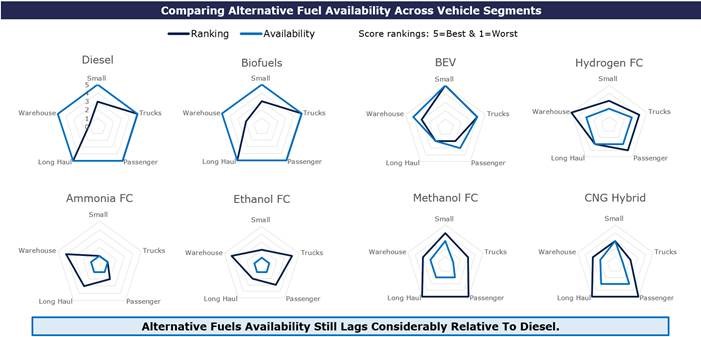Total Pages: 19
Table Of Contents
- Key Takeaways – Page 2
- W|EPC Rankings: Fuels vs Fuel Cells – Page 3
Alternative Fuels – Applications
- Vehicle Applications – Page 5
- Vehicle Availability – Page 6
- Comparing Application vs Availability – Page 7
Vehicle Transportation – Fuel Comps
- Small Vehicle Range – Page 9
- Energy Density & Vehicle Range: Small Vehicles – Page 10
- Energy Density & Vehicle Range: Mid-Sized & Trucks – Page 11
- Semi Truck Considerations – Page 12
- Energy Density & Vehicle Range: Freight & Semis – Page 13
Technology Leaders and Applications
- Fuel Cell Companies and Applications – Page 15
- Hydrogen Roadmap to Transportation – Page 16-17
- Contact Info & Disclosures – Pages 18-19
Key Takeaways:
1) Alternative Fuel Analysis…Will History Repeat Itself? In 1992 & 2005, the Department of Energy (DOE) created & amended the Energy Policy Act (EPA) that addressed fuel research and tax benefits for vehicle manufacturing.
Battery Electric Vehicles (BEV), Hydrogen (H2), Hybrids, Biofuels, Ethanol and Methanol were analyzed in 2005, but vehicle manufacturers supported gasoline hybrid vehicles due to technology and production constraints.
Since then, fuel cell technology and global, federal, & state emission guidelines have accelerated innovation and the market is now actively deciding transportation alternatives.
2) Small Vehicle Applications: BEV have taken a leading role in the small vehicle category with minimal competition from Hydrogen.
Hydrogen’s price, lack of infrastructure, and safety concerns highlight the risk associated with new fuel applications; however, Methanol may have an opportunity to fill this role.
3) Mid-Sized Vehicles and Truck Applications: Fuel energy density becomes a larger role as the size of a vehicle increases. Fuel storage capacity, energy density, and vehicle efficiency play a large role in the range and cost for a vehicle.
Chevy Silverado 1500: 1000 miles & ~$0.11/mile
Tesla/Rivian: 400-500 miles & $0.05/mile
Nikola Badger (on hold): 600 miles & ~$0.20/mile
4) Semi-Truck Range Is A Gating Issue For Future Fuels
New Semi-Truck concepts are ranging from shorter applications (<300 miles) to the long-haul market (>600 mile/day).
Hydrogen will be limited by fuel price and infrastructure but by using Methanol as an energy dense carrier for Hydrogen in the vehicle may allow for equivalent distance at ~1/6 the cost.


 client log-in
client log-in




